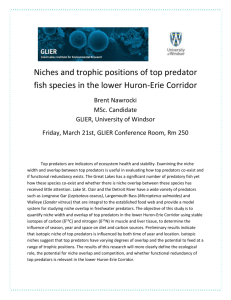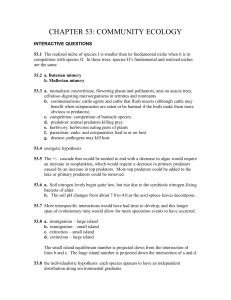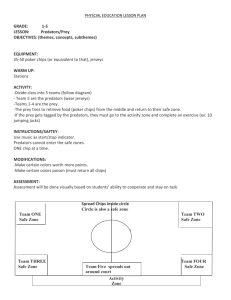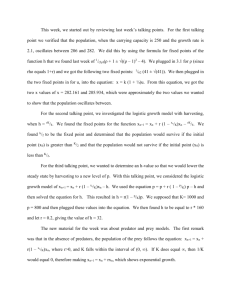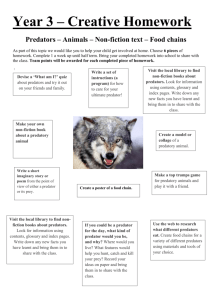IDENTIFY WITH REFERENCE TO ECOLOGY
advertisement
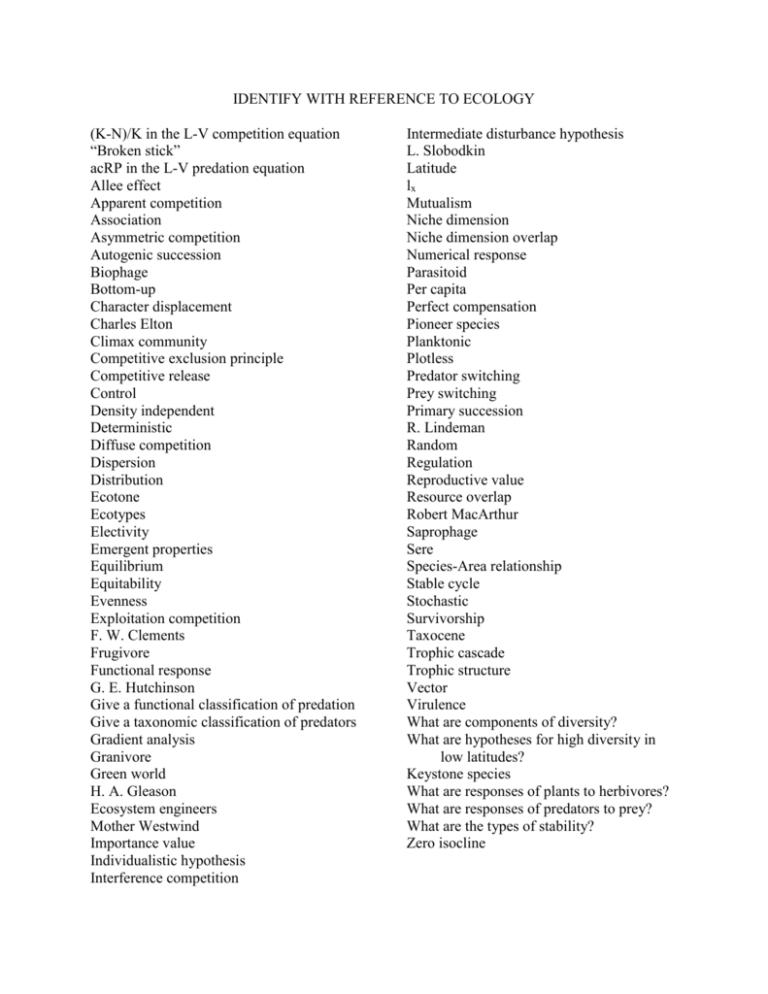
IDENTIFY WITH REFERENCE TO ECOLOGY (K-N)/K in the L-V competition equation “Broken stick” acRP in the L-V predation equation Allee effect Apparent competition Association Asymmetric competition Autogenic succession Biophage Bottom-up Character displacement Charles Elton Climax community Competitive exclusion principle Competitive release Control Density independent Deterministic Diffuse competition Dispersion Distribution Ecotone Ecotypes Electivity Emergent properties Equilibrium Equitability Evenness Exploitation competition F. W. Clements Frugivore Functional response G. E. Hutchinson Give a functional classification of predation Give a taxonomic classification of predators Gradient analysis Granivore Green world H. A. Gleason Ecosystem engineers Mother Westwind Importance value Individualistic hypothesis Interference competition Intermediate disturbance hypothesis L. Slobodkin Latitude lx Mutualism Niche dimension Niche dimension overlap Numerical response Parasitoid Per capita Perfect compensation Pioneer species Planktonic Plotless Predator switching Prey switching Primary succession R. Lindeman Random Regulation Reproductive value Resource overlap Robert MacArthur Saprophage Sere Species-Area relationship Stable cycle Stochastic Survivorship Taxocene Trophic cascade Trophic structure Vector Virulence What are components of diversity? What are hypotheses for high diversity in low latitudes? Keystone species What are responses of plants to herbivores? What are responses of predators to prey? What are the types of stability? Zero isocline DISCUSSION QUESTIONS “Animals do not overeat their food supply because this would result in individual hardship[be damaging for the population and would decrease the fitness of their offspring.” Discuss this statement and use examples from the real world to support your answer where appropriate. Develop a model, based on the Lotka-Volterra model that describes the population dynamics of two mutualistic species. Differentiate between food chain lengths and interaction strengths Discuss at least two major contributions of J. Connell to Ecological thought. From the biological/ecological viewpoint, should undocumented aliens in the US receive government sponsored health care? Defend your position mathematically Why is the world green? In nature how do most large herbivores die? Support your answer with data from field research. Discuss how numerical response and functional response of predators might interact. Discuss in words the conditions – predicted by the Lotka-Volterra model – that would allow the coexistence of two competing species. How do you think such a situation could occur in natural conditions? Why do parasites sometimes increase virulence? Discuss the contributions of G. F. Gause to ecological theory. What is ecological efficiency? What does it tell us about how food webs function? How does food web theory accommodate parasitoids. Discuss the difference between density dependent and density independent factors. Support the answer with examples from the real world. Why don’t predators exterminate their prey? Show how this can occur given the way natural selection operates. What features would make a species a good indicator of community ‘health’? Discuss the difference between predators controlling their prey and predators regulating their prey. The Lotka-Volterra models are deterministic. Since we know that parameters external to the models (ex. seasonality) change discuss conceptually how you would incorporate such changes into the models. How important is mutualism in temperate communities? Support your answer with data from field studies. How would you demonstrate density dependence? Outline the experimental design you would use and how you would analyze the data. Discuss, using appropriate examples, how intra- and interspecific competition might influence the physical structure of communities. Compare and contrast grassland communities and open water planktonic communities. Support your answer with data from field studies. Evaluate factors that have been suggested as explanations of the latitudinal gradient in species diversity Discuss alternate stable states. Use real examples in your discussion and evaluate their appropriateness. What do indices of ‘similarity’ tell us about communities? Discuss how such indices work, and what they do with the data. Evaluate the usefulness of the guild concept. Discuss the ‘broken stick’ model. How well does it describe nature? Support your answer with data from data from field studies. How could the number of links in trophic systems determine community structure. Use real examples/data. How does assimilation efficiency influence trophic pyramids? How does it affect predator dynamics in the Lotka-Volterra model? Differentiate between microparasites and macroparasites. Both the Shannon-Wiener and the Simpson diversity measures use proportional representation of individuals. How do they differ in the importance given to rare species? How does food web theory accommodate omnivores? In nature how do most predators die? Support your answer with data from field research. Discuss hypotheses for the observed latitudinal increase in diversity. What evidence is there to support/refute these hypotheses? How does the concept of equilibrial communities fit with observations? Use actual data in this evaluation. In vector transmitted diseases, why is β (the transmission rate) squared? In the last 10 years what have field experiments shown about the niche overlap hypothesis? Many parasite caused diseases can result in the death of the host. How does this affect the parasitic organism, and why haven’t host and parasite co-evolved to prevent this? Often people speak of ‘vacant niches’ Discuss this idea. Is it appropriate use of the term? Discuss hypotheses that have been offered for species diversity in tropical rainforests Outline the theory of island biogeography Both the variance mean ratio method and the Greig-Smith method use quadrats to give insight into the spatial distribution of organisms. How are they similar, how do they differ in application and what they tell us about community spatial structure? Stability is often cited as an important factor leading to high species diversity. Describe how this might be in light of the niche overlap model. How can the complexity of life on Earth seem to increase given the restrictions of the second law of thermodynamics? What do saprophages eat? How does this affect food web structure? What features of marine benthic communities might make models of succession there differ from what has been studies on land? Discuss Robert May’s ideas about diversity/stability in light of research in the past 10 years. What is the paradox of the plankton? What ecological question does it address? Why has most of the controversy over the nature of the community been among plant ecologists rather than zoologists? Why is the world brown? How do inhibition and tolerance differ? Compare and contrast the development of community in the botanical community and the zoological community. Give the important names, dates and developments. How might diffuse competition work? How about indirect competition? What is a community matrix? How could it be used? Discuss how you would go about determining the competition coefficients for a three species community. What are responses of herbivores to predators? Discuss the advantages and disadvantages of meta-analyses of ecological studies.

